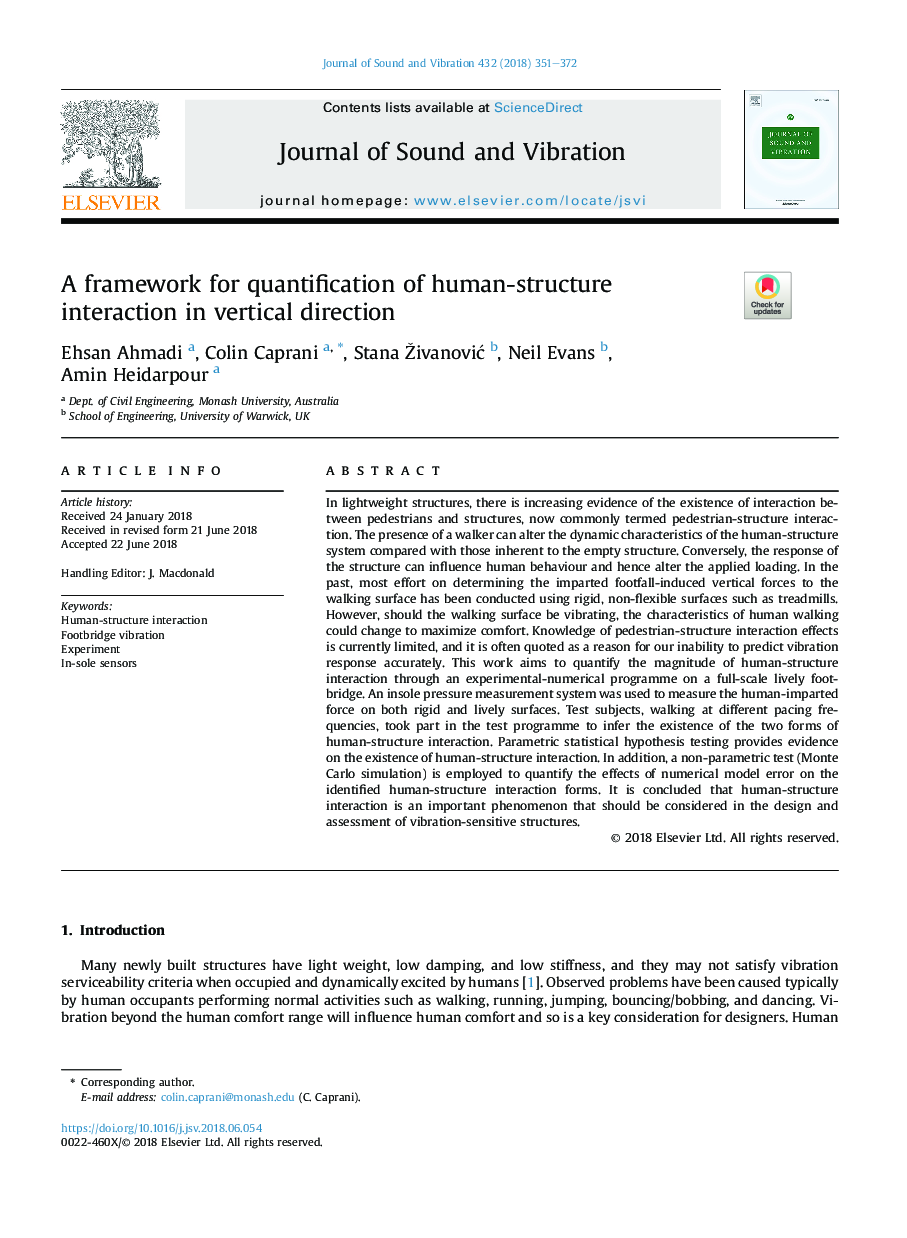| کد مقاله | کد نشریه | سال انتشار | مقاله انگلیسی | نسخه تمام متن |
|---|---|---|---|---|
| 6752849 | 1430801 | 2018 | 22 صفحه PDF | دانلود رایگان |
عنوان انگلیسی مقاله ISI
A framework for quantification of human-structure interaction in vertical direction
ترجمه فارسی عنوان
چارچوبی برای اندازه گیری تعامل ساختار انسان در جهت عمودی
دانلود مقاله + سفارش ترجمه
دانلود مقاله ISI انگلیسی
رایگان برای ایرانیان
کلمات کلیدی
تعامل انسان و ساختار، ارتعاش پاسیو آزمایشی تنها سنسورها،
ترجمه چکیده
در ساختار سبک وزن، شواهد فراوانی وجود وجود تعامل بین عابران پیاده و ساختارها وجود دارد که در حال حاضر معمولا تعامل ساختار عابر پیاده را نامیده اند. حضور واکر می تواند ویژگی های پویا سیستم ساختار انسان را در مقایسه با آنچه که به ساختار خالی ذاتی است، تغییر دهد. در مقابل، پاسخ ساختار می تواند بر رفتار انسان تاثیر بگذارد و از این رو بارگذاری کاربردی را تغییر دهد. در گذشته، بیشترین تلاش برای تعیین نیروهای عمودی ناشی از حرکت پایینی به سطح پیاده روی با استفاده از سطوح سخت و غیر قابل انعطاف مانند تردمیل انجام شده است. با این حال، اگر سطح پیاده روی ارتعاش یابد، ویژگی های راه رفتن انسان می تواند به راحتی بیشتر تغییر کند. آگاهی از اثرات متقابل ساختار عابر پیاده در حال حاضر محدود است و اغلب به عنوان دلیل عدم توانایی ما برای پیش بینی پاسخ لرزش به طور دقیق نقل شده است. این کار با هدف اندازه گیری میزان تعامل ساختار انسان با استفاده از یک برنامه عددی آزمایشگاهی در یک پایانه پر جنب و جوش در مقیاس کامل محاسبه می شود. برای اندازه گیری نیروی انسانی در هر دو سطح سفت و محکم استفاده شد. افراد آزمایشی که در فرکانس های گشتزنی مختلف پیاده روی می کنند، در برنامه تست شرکت کردند تا وجود دو شکل از تعامل ساختار انسان را بیاموزند. آزمون فرضیه آماری پارامتری شواهدی در مورد وجود تعامل ساختار انسان ارائه می دهد. علاوه بر این، آزمون غیر پارامتری (شبیه سازی مونت کارلو) برای اندازه گیری اثرات خطای مدل عددی در فرم های تعامل ساختار انسان مورد استفاده قرار می گیرد. نتیجه گیری می شود که تعامل انسان و ساختار یک پدیده مهم است که باید در طراحی و ارزیابی سازه های حساس به ارتعاش مورد توجه قرار گیرد.
موضوعات مرتبط
مهندسی و علوم پایه
سایر رشته های مهندسی
مهندسی عمران و سازه
چکیده انگلیسی
In lightweight structures, there is increasing evidence of the existence of interaction between pedestrians and structures, now commonly termed pedestrian-structure interaction. The presence of a walker can alter the dynamic characteristics of the human-structure system compared with those inherent to the empty structure. Conversely, the response of the structure can influence human behaviour and hence alter the applied loading. In the past, most effort on determining the imparted footfall-induced vertical forces to the walking surface has been conducted using rigid, non-flexible surfaces such as treadmills. However, should the walking surface be vibrating, the characteristics of human walking could change to maximize comfort. Knowledge of pedestrian-structure interaction effects is currently limited, and it is often quoted as a reason for our inability to predict vibration response accurately. This work aims to quantify the magnitude of human-structure interaction through an experimental-numerical programme on a full-scale lively footbridge. An insole pressure measurement system was used to measure the human-imparted force on both rigid and lively surfaces. Test subjects, walking at different pacing frequencies, took part in the test programme to infer the existence of the two forms of human-structure interaction. Parametric statistical hypothesis testing provides evidence on the existence of human-structure interaction. In addition, a non-parametric test (Monte Carlo simulation) is employed to quantify the effects of numerical model error on the identified human-structure interaction forms. It is concluded that human-structure interaction is an important phenomenon that should be considered in the design and assessment of vibration-sensitive structures.
ناشر
Database: Elsevier - ScienceDirect (ساینس دایرکت)
Journal: Journal of Sound and Vibration - Volume 432, 13 October 2018, Pages 351-372
Journal: Journal of Sound and Vibration - Volume 432, 13 October 2018, Pages 351-372
نویسندگان
Ehsan Ahmadi, Colin Caprani, Stana ŽivanoviÄ, Neil Evans, Amin Heidarpour,
